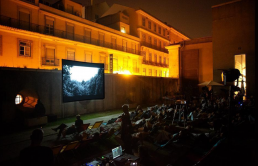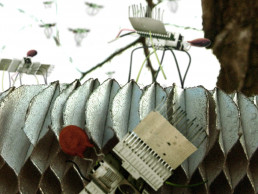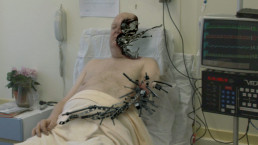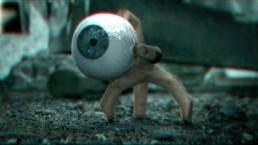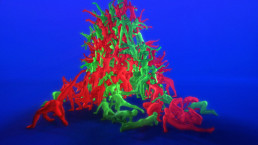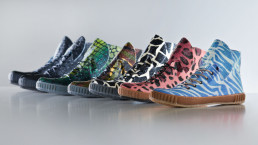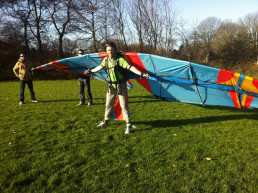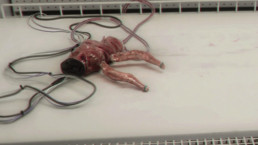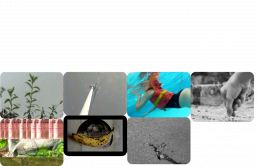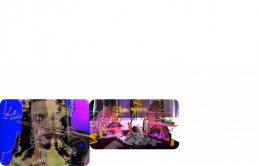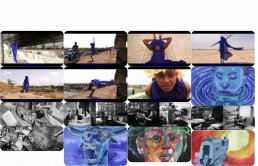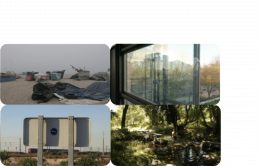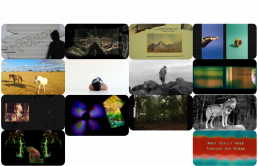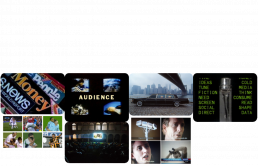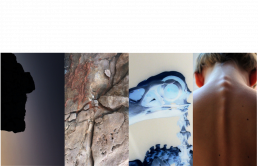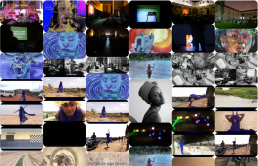“FUSO 2019 – 27 Agosto a 1 Setembro
30 Agosto, 22h
Jardim do Museu Nacional de Arte Contemporânea do Chiado
Programa de TOM VAN VLIET (Holanda)
O UNIVERSO DE FLORIS KAAYK
Duração: 48’
A obra de Floris Kaayk foca conceitos e fantasias futuristas, visualiza o progresso tecnológico, por vezes demonstrando as suas vantagens, mas também as suas consequências negativas.
Floris Kaayk tornou-se conhecido com os seus semi-documentários de ficção The Order Electrus e Metalosis Maligna. Os seus filmes de animação receberam diversos prémios internacionais. Em 2011, The Origin of Creatures foi seleccionado como participação holandesa nos Prémios da Academia na categoria de Melhor Curta Metragem de Animação. No mesmo ano, Kaayk foi notícia devido aos diversos vídeos publicados nas redes sociais no weblog do seu alter ego, Jarno Smeets, que afirmava ser o primeiro ser humano capaz de voar como um pássaro. Diversas estações de televisão internacionais usaram imagens destes vídeos nos seus noticiários.
Outro dos seus projectos foi Rayfish Footwear (2012), uma empresa fictícia e loja online que convidava pessoas a cultivar os seus próprios ténis personalizados usando pele de raia geneticamente modificada. Uma narrativa cuidadosamente preparada era distribuída através de diversas plataformas media, nas quais provou ser suficientemente credível para um grupo de fiéis seguidores, que acabaram por ficar desiludidos quando a verdade foi revelada.
O projecto experimental online The Modular Body (2016 – 2019) visualiza o futuro no qual um protótipo do corpo humano foi desenhado e criado usando impressão em 3D e tecnologias de cultura de células. Os vídeos que apresentam o personagem central, Oscar – um Homem Modular protótipo criado com vários módulos de auto-montagem – são incrivelmente realistas. Neste projecto, Kaayk foi claro quanto à natureza fictícia das imagens, deixando espaço para as interpretações e crenças dos espectadores.
No recente festival STRP em Eindhoven, Floris Kaayk lançou o seu último projecto: Next Space Rebels. É um jogo inovador sobre a democratização do universo e a busca por uma internet independente.
As comunidades espaciais open source que desenvolvem foguetões e satélites a baixo custo desempenham um papel muito importante no jogo. O objectivo é trazer os foguetões para uma órbita mais baixa ao redor da Terra e transformar o espaço num novo domínio público.
Em 2014, Kaayk venceu o Prémio de Artes Visuais Volkskrant com os seus filmes de animação e semi-documentários. Em 2016, o seu vídeo para a canção Witch Doctor, da banda de rock alternativo De Staat recebeu diversos prémios, incluindo um Prémio de Vídeo Musical no Reino Unido e o Prémio Edison, um Prémio de Vídeo Musical europeu. Em 2016, The Modular Body venceu o Prémio Golden Calf no Netherlands Film Festival (Festival de Cinema da Holanda) na categoria de “Melhor Obra Interactiva”. Em 2017, Kaayk recebeu o prémio Witteveen+Bos para Arte e Tecnologia pela sua obra completa.
BIO
Tom Van Vliet (Holanda) iniciou em 1982 o célebre World Wide Video Festival e dirigiu o festival até 2004. De 1984 até 1996 foi também director do Kijkhuis, Centro de Arte Contemporânea. Foi curador de exposições de Tony Oursler, Nan Hoover, Madelon Hooykaas e Elsa Stansfield, Nam June Paik, Keith Piper, Klaus vom Bruch, Gary Hill, Marie-Jo Lafontaine, Walid Ra’ad, Darya von Berner e a exposição Double Vision on the aesthetic and conceptual aspects of the multiple image. Foi comissário e produziu várias instalações de vídeo de Nalini Malani, Michal Rovner e Eder Santos, entre outros, e foi curador de exposições para o Museu Stedelijk, Museu Reina Sofia, Bienal de Fukui, Paisagem de Luz e Bienal de Pusan. Tom van Vliet foi o precursor da construção de um panorama de projecções em 360 graus e comissariou obras a vários artistas. Também organizou uma série de projecções ao ar livre e de mapping com Pipilotti Rist, General Idea e Pablo Valbuena, entre outros.
_FLORIS KAAYK (NL) // The Order Electrus, 2005, 7’20’’
The Order Electrus (2005) é um documentário ficcionado que apresenta o mundo imaginário de Floris Kaayk com uma natureza industrializada, situado na zona devoluta de Ruhr (Alemanha). Devido à sobrecapacidade nos sistemas de produção, muitas fábricas na Alemanha foram forçadas a fechar. Ao longo de muitos anos, estas zonas industriais devolutas tornaram-se terreno de criação para uma espécie de insectos eléctricos, também denominada The Order Electrus. Estes insectos evoluíram através da fusão entre a natureza e a tecnologia.
_FLORIS KAAYK (NL) // Metalosis Maligna, 2006, 7’27’’
A história de Metalosis Maligna é contada num documentário ficcionado sobre esta doença, que afecta doentes com implantes médicos. A Metalosis Maligna ocorre quando um implante metálico interage prejudicialmente com o tecido humano, fazendo com que se desenvolvam gavinhas no metal, que eventualmente perfuram a pele e destroem partes do corpo humano. O filme mostra o desenvolvimento da doença nas suas fases iniciais até fases mais avançadas e sangrentas, nas quais pedaços inteiros de carne acabam por cair e tudo o que resta é um esqueleto de sucata.
_FLORIS KAAYK (NL) // The Origin of Creatures, 2010, 12’05’’
Uma visão futurista do mundo após um desastre catastrófico. Nesta parábola obscura, membros mutantes procuram colaboração, mas devido a falhas na comunicação esta missão está condenada ao fracasso. A narrativa de The Origin of Creatures baseia-se num dos contos mais conhecidos sobre colaboração, A Torre de Babel. Este conto é transformado e deturpado para apresentar um futuro imaginário, após o mundo ser abatido por uma catástrofe.
Entre os resquícios de uma cidade devastada vive aquilo que resta da humanidade. Corpos humanos são divididos em partes separadas do corpo e fundidas em seres especiais. Juntas, estas criaturas formam uma colónia e apenas podem sobreviver se colaborarem umas com as outras. Nos destroços dos edifícios destruídos, tentam criar um ninho tão grande e alto quanto possível, para que a rainha da colónia possa ter luz solar suficiente para se reproduzir, mas devido às falhas de comunicação, esta missão está condenada ao fracasso.
_FLORIS KAAYK (NL) // Juxtaposis, 2011, 3’59’’
Juxtaposis expõe o princípio “crescer através da luta”, o mecanismo que cria a evolução na natureza. Diversos organismos tentam ganhar terreno conquistando partes dos corpos uns dos outros. Através desta batalha, crescem e tornam-se seres cada vez mais complexos. Juxtaposis é produzido em colaboração com Machinefabriek, o alter ego de Rutger Zuydervelt. A música de Machinefabriek combina elementos do ambiente, ruído, minimalismo, drones, gravações no terreno e experiências electro-acústicas.
_FLORIS KAAYK, KOERT VAN MENSVOORT & TON MEIJDAM (NL) // The Rise and Fall of Rayfish Footwear, 2013, 7’10’’
Rayfish Footwear cria ténis personalizados feitos a partir de pele genuína de raia. A inovadora técnica de bio-personalização permite-nos desenhar os nossos próprios Rayfish transgénicos. A Rayfish Footwear explora a beleza e a variedade da natureza para criar os primeiros ténis verdadeiramente personalizados em todo o mundo. Com a ferramenta de design online, é possível criar um padrão exclusivo para os ténis Rayfish. Podemos seleccionar elementos de dezenas de padrões animais e combiná-los com algo que a própria natureza nunca poderia ter imaginado.
Rayfish Footwear opera há mais de uma década, criando raias em instalações de aquacultura na Tailândia. A Rayfish Footwear é uma empresa familiar com uma longa tradição na produção de calçado artesanal com pele de raia. Em 2011, a Rayfish Footwear concebeu, com sucesso, a primeira raia totalmente bio-personalizada. Cada sapato é produzido de acordo com o princípio “um peixe, um sapato”.
_FLORIS KAAYK (NL) // Human Birdwings, 2011, 3’46’’
A história transmedia de Jarno Smeets, um jovem que sonha voar como um pássaro e acredita saber como tornar este sonho em realidade. Este retrato do grande sonho de voar alcançou milhões de pessoas e tornou-se manchete em diversos media mundiais. A história alcançou mais de 10 milhões de visualizações online e 25.000 reacções no Youtube. A história foi abordada por grandes media como BBC, Wired, Daily Mail, Gizmodo, TechCrunch, Discovery e muitos media holandeses. Foram contabilizados mais de 30.000 tweets e cerca de 1000 reacções no blog de Jarno.
_FLORIS KAAYK (NL) // The Modular Body, 2016-19, 5’32’’
The Modular Body é uma história de ficção científica sobre a criação de OSCAR, um organismo vivo criado a partir de células humanas. O protagonista é Cornelis Vlasman, um biólogo versátil para quem um percurso já conhecido é uma das definições mais aborrecidas.
Juntamente com algumas pessoas da mesma opinião, abre um laboratório independente no qual faz experiência com materiais orgânicos. O organismo primitivo e vulnerável que resulta das tentativas de Vlasman é OSCAR.
O protótipo, com o tamanho de uma mão humana, consiste em módulos de órgãos clicáveis. OSCAR é mantido vivo com sangue retirado do próprio biólogo e é regularmente vacinado contra infecções, por não ter sistema imunitário. A história refere-se a diversas narrativas semelhantes na literatura e cinema mundial, mais precisamente, Frankenstein de Mary Shelley.
BIO
Floris Kaayk (1982) terminou a sua licenciatura summa cum laude (com a Maior das Honras) no Departamento de Animação da Academia de Arte e Design AKV St. Joost, em Breda, tendo realizado o seu mestrado em Belas Artes no Instituto Sandberg em Amesterdão. Em 2014, Kayak recebeu o prémio de Artes Visuais Volkskrant pelos seus filmes de animação e semi-documentários. Em 2016, The Modular Body venceu um prémio Golden Calf no Festival de Cinema da Holanda (Netherlands Film Festival) na categoria de “Melhor Obra Interactiva”. Em 2017, Kaayk recebeu o prémio Witteveen+Bos na categoria Arte e Tecnologia pela sua obra completa.
“FUSO 2019 – August 27 to Septembre 1“
August 30, 10pm
Jardim do Museu Nacional de Arte Contemporânea do Chiado
Program by TOM VAN VLIET (The Netherlands)
THE UNIVERSE OF FLORIS KAAYK
Running Time: 48’
Floris Kaayk’s work focuses on futuristic concepts and fantasies, and visualises technological progress, sometimes by demonstrating its advantages and at other times by presenting negative consequences.
Kaayk became known with his fictional semi documentaries The Order Electrus and Metalosis Maligna. His animated films have received several international awards. In 2011, The Origin of Creatures was selected as the Dutch entry for the Academy Awards in the Best Animated Short Film category. In that same year, Kaayk made headlines with a number of social media videos posted on the weblog of his alter ego, Jarno Smeets, who claimed to be the first human able to fly like a bird. International television stations used the images in their news programme.
Another project was Rayfish Footwear (2012), a fictitious company and web shop that invited people to grow their own personalised sneakers using genetically modified stingray leather. A carefully prepared narrative was distributed via various media platforms, where it proved sufficiently credible for a loyal group of followers, who were eventually disappointed when the truth was revealed.
The experimental online project The Modular Body (2016 – 2019) visualises a future where a prototype of the human body has been designed and created using 3D printing and cell culture technologies. The videos featuring the central character Oscar – a prototype Modular Man made up of various self-assembly modules – are frighteningly realistic. In this project, Kaayk was clear about the fictitious nature of the images from the start while leaving room for viewers’ own interpretations and beliefs.
At the recent STRP festival in Eindhoven Floris Kaayk released his latest project: Next Space Rebels. Next Space Rebels is an innovative game about the democratising of the universe and the pursuit of an independent internet. Open source space-communities that develop rockets and satellites at low cost play a large role in the game. The aim is to bring the rockets into a lower orbit around the Earth and to transform space into a new public domain.
In 2014, Kaayk won the de Volkskrant Visual Arts Prize for his animated films and semidocumentaries. In 2016, his video for the song Witch Doctor by Dutch alternative rock band De Staat received numerous prizes, including a UK Music Video Award, an Edison Award, and a European Music Video Award. In 2016, The Modular Body won a Golden Calf Award at the Netherlands Film Festival in the ‘Best Interactive Work’ category. In 2017 Kaayk received the Witteveen+Bos award for Art+Technology for his complete oeuvre.
BIO
Tom Van Vliet (Netherlands) initiated in 1982 the renowned World Wide Video Festival and directed the festival until 2004. From 1984 till 1996 he was also director of the Kijkhuis, centre of contemporary art. He curated exhibitions by Tony Oursler, Nan Hoover, Madelon Hooykaas & Elsa Stansfield, Nam June Paik, Keith Piper, Klaus vom Bruch, Gary Hill, Marie-Jo Lafontaine, Walid Ra’ad, Darya von Berner and the exhibition Double Vision on the aesthetic and conceptual aspects of the multiple image. He commissioned and produced several video installations by, among others, Nalini Malani, Michal Rovner and Eder Santos and curated exhibitions for the Stedelijk Museum, Reina Sofia Museum, Biennale of Fukui, Paisagem de Luz and Pusan Biennial. Tom van Vliet initiated a 360-degree moving image panorama and has commissioned works to various artists. He also curated a series of outdoor projections and mapping among others with Pipilotti Rist, General Idea, and Pablo Valbuena.
_FLORIS KAAYK (NL) // The Order Electrus, 2005, 7’20’’
The Order Electrus (2005) is a fictional documentary which shows Floris Kaayk’s imaginary world of industrialised nature, situated in a derelict area of the Ruhr (Germany). Due to overcapacity in production systems, many factories in Germany were forced to close down. Over the course of many years these derelict industrial areas became a breeding ground for an electrical insects species, also called The Order Electrus. These insects evolved through the merging with nature and technology.
_FLORIS KAAYK (NL) // Metalosis Maligna, 2006, 7’27’’
The story of Metalosis Maligna is told in a fictional documentary about this disease, that effects patients with medical implants. Metalosis Maligna occurs when a metal implant interacts badly with human body tissue, causing the metal to grow tendrils, which eventually puncture the skin from within and causes parts of the body destroyed. The movie shows the development of the disease from its early stages through to the gory advanced stages, by which point entire sections of flesh have fallen away and all that is left is a skeleton of scrap metal.
_FLORIS KAAYK (NL) // The Origin of Creatures, 2010, 12’05’’
A futuristic vision of a world after a catastrophic disaster. In this dark parable mutated limbs are looking for cooperation, but due to miscommunication this mission is doomed to fail. The storyline of The Origin of Creatures is based on one of the most well-known tales about collaboration, the Tower of Babel. This tale is transformed and twisted and is set in an imaginary future, after the world is hit by a catastrophe. Among the remains of a devastated city lives that what is left of humanity. Human bodies are divided into separated parts of the body and are fused to special beings. Together, these creatures form a colony, they can only survive when collaborating. In the rubble of destroyed buildings they are trying to build a nest as large and as high as possible, so that the colony’s queen gets enough sunlight to reproduce, but due to miscommunication this mission is doomed to fail.
_FLORIS KAAYK (NL) // Juxtaposis, 2011, 3’59’’
Juxtaposis exposes the principle ‘growth through battle’, the mechanism that creates evolution in nature. Various organisms try to gain terrain by conquering parts of each other’s bodies. Through this battle they grow into more and more complex beings. Juxtaposis is produced in collaboration with Machinefabriek the alias of Rutger Zuydervelt. The music of Machinefabriek combines elements of ambient, noise, minimalism, drone, field recordings and electro-acoustic experiments.
_FLORIS KAAYK, KOERT VAN MENSVOORT & TON MEIJDAM (NL) // The Rise and Fall of Rayfish Footwear, 2013, 7’10’’
Rayfish Footwear creates personalized sneakers made from genuine stingray leather. The groundbreaking bio-customization technique allows you to design your very own transgenic Rayfish. Rayfish Footwear harnesses the beauty and variety of nature to create the world’s first truly custom sneakers. With the online design tool, you can create a unique pattern for your own Rayfish stingray. Select elements from dozens of animal patterns and remix them into something nature could have never imagined.
Rayfish Footwear has been in operation for over a decade, raising stingrays in the Thai aquaculture facility. Rayfish Footwear is a family-run company with a long organic tradition in creating handcrafted shoes from stingray leather. In 2011, Rayfish Footwear successfully engineered the first fully bio-customized stingray. Each shoe is crafted according to the ‘one fish, one shoe’ principle.
_FLORIS KAAYK (NL) // Human Birdwings, 2011, 3’46’’
The transmedia story of Jarno Smeets. A young man who dreams flying like a bird and thinks he knows to make that dream come true. This portrayal of the ultimate flying dream reached millions of people and became worldwide headline news. The story reached over 10 million online views and 25.000 reactions on YouTube. The story was also covered by major media like BBC, Wired, Daily Mail, Gizmodo, TechCrunch, Discovery and many Dutch media. Over 30.000 tweets and near to 1.000 reactions to Jarno’s blog were counted.
_FLORIS KAAYK (NL) // The Modular Body, 2016-19, 5’32’’
The Modular Body is an online science fiction story about the creation of OSCAR, a living organism built from human cells. The protagonist is Cornelis Vlasman, a versatile biologist for whom the path well-travelled is the most uninteresting one by definition.
Together with a few like-minded people he therefore starts an independent laboratory in which he experiments with organic materials. The primitive, vulnerable organism that finally results from Vlasman’s endeavours is OSCAR. The prototype, in the size of a human hand, consist of clickable organ modules. OSCAR is kept alive with blood taken from Vlasman and is continually vaccinated against infections, as it has no immune system. The story refers to various similar narratives in world literature and film history, notably Mary Shelley’s Frankenstein.
BIO
Floris Kaayk (1982) graduated summa cum laude from the animation department of AKV St. Joost academy of Art and Design in Breda, and gained a Master of Fine Arts degree from the Sandberg Institute in Amsterdam. In 2014, Kaayk won the de Volkskrant Visual Arts Prize for his animated films and semidocumentaries. In 2016, The Modular Body won a Golden Calf Award at the Netherlands Film Festival in the ‘Best Interactive Work’ category. In 2017 Kaayk received the Witteveen+Bos award for Art+Technology for his complete oeuvre.
